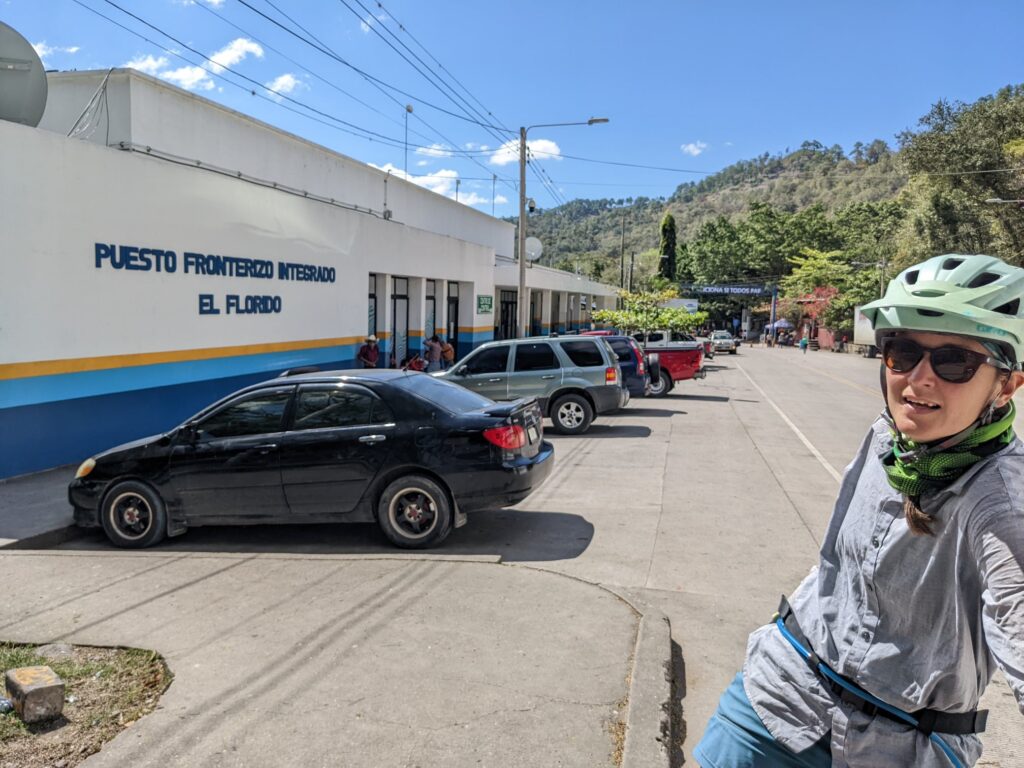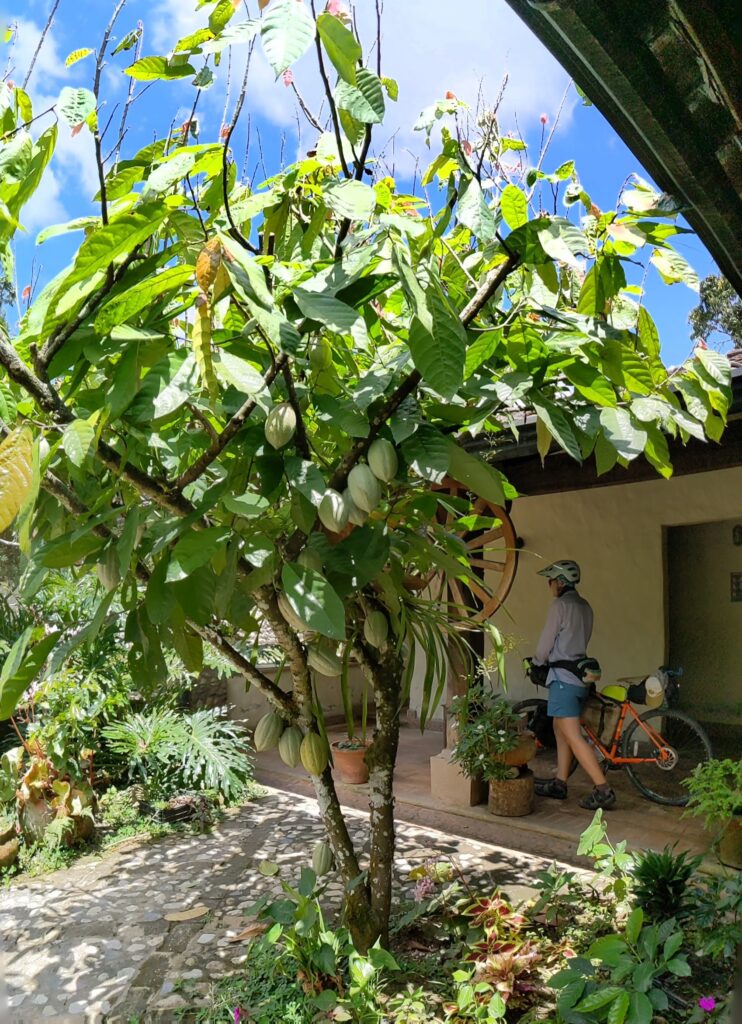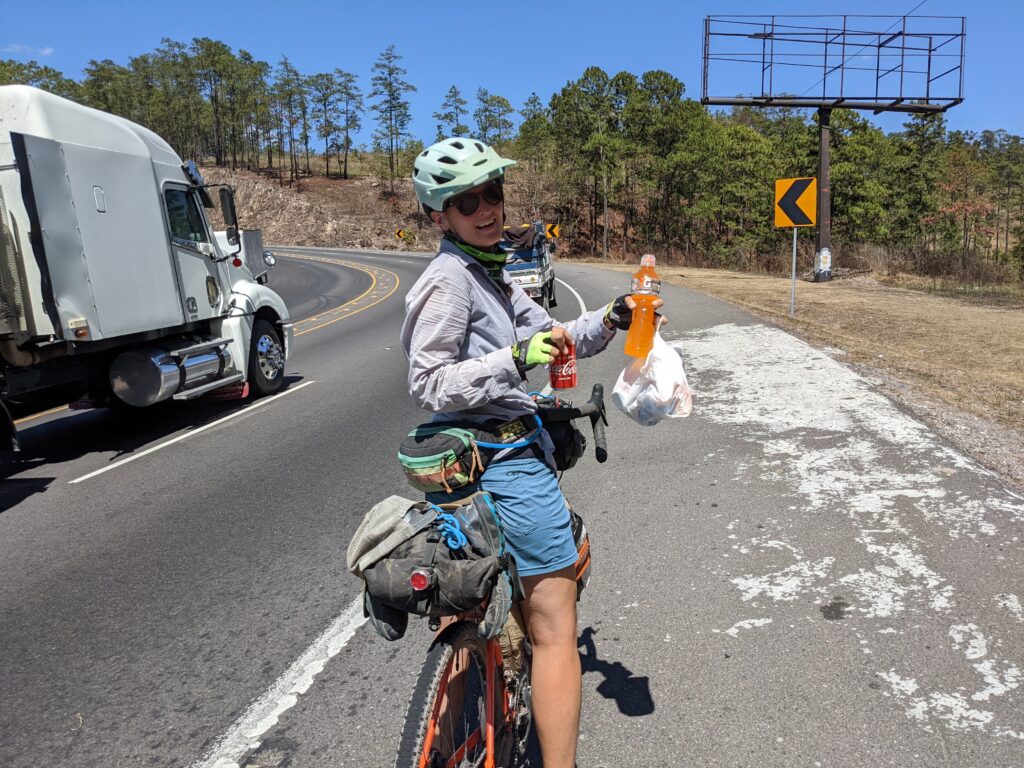In brief I would say the western highlands and Cordillera Central are beautiful and welcoming enough to warrant slow travel. East of Tegucigalpa is not an area to loiter unless you come as humanitarian aid.
![]()
El Florido was the smoothest, calmest border crossing in a long time. This stretch was an oasis, both for our spirits and for our fellow migrators, the birds and butterflies. With infrastructure around Ruinas Copan and a variety of travel routes, such as the Ruta del Café and the Lenca route, the efforts at cultivating tourism are evident. Both are intended as

On our first day into the country, we arrived to Ruinas Copan, the ‘Paris’ of the Maya civilization, in decline after the fall of 18 Rabbit. Abandoned somewhere in the 1100s, well before the Spanish arrived, the Ceiba trees and macaws were its silent guardians until 1576 when Diego Garcia de Palacio reported it. It wasn’t excavated until John Lloyd Stephens and Frederick Catherwood (the Lewis and Clarke of archeology in the region) began to document and map the ancient, hidden, city.
![]()
![]()
![]()
![]()
After that we connected to the Lenca Route which leads across the Highlands of Western Honduras. Some of the young, enterprising generation of the Lenca people (the quieter and more subtle fabric pattern neighbors to the Maya), realized that travelers appreciate having a route laid out before us and knowing where we will be welcomed. So, they have mapped, equipped, and adapted a series of their laid back little mountain pueblos in an effort to attract tourism to their beautiful and often overlooked region.
![]()
![]()
We stay powered up on coffee from small local stands, open palapas, in front of the hillsides of bean crops. Many even had WiFi! I again had that sensation of being a princess when we could take shade and wait out the most sweltering hours of the day over a frappé.
I found it interesting that the coffee plants were often inter-cropped with banana trees. The workers seemed generally cheerful and one evening when we were racing the consistently 6:15 sunset, a small fruit stand even insisted on giving us a carton of juice when we rolled past. They refused payment so instead I fielded their questions and got to talking with their young daughter, playing out an mini English lesson.

![]()
![]()
I had been excited to find a couple studies and archeological papers about a site variously called.
El Gigante Rockshelter/Gruta el Gigante/Cuevadel Gigante a site on the UNESCO World Heritage Site Tentative List.
“Since the vault protects the shelter’s interior from rain and wind, the sediments inside have accumulated through thousands of years of use [11,000+].
This peculiar situation has preserved a long sequence of occupation in a very dry micro-environment where not only stone artifacts have been registered, but also remnants of woven fibers and leather. In fact, El Gigante has one of the largest collections of preserved basketry and textiles in Mesoamerica. 10,300-year-old cordage is the oldest directly dated perishable artifact from Mesoamerica.
Also human remains are present and a variety of bones from faunal species (dear, armadillo, rabbit, crabs), as well as plant remains (hog plums, avocado, soursop, and wild beans), and in the most recent phases, also cobs of early domesticated corn.
The large assemblage of well-preserved corns [over 10,000], beans, and squash provide unique information on the timing and trajectory of plant domesticates in Central America, also of importance for Mesoamerica proper. The use of a wide range of semi-domesticated tree resources (ciruela, coyol palms, several sapote species, acorns among others) provide valuable insight into how humans managed their resource rich tree environment. Specially, the large sample of thousands of avocado rinds and pits provide an unparalleled view of this very important tree domesticate.
Although there are other rockshelters in Central Honduras, none of them have comparable deposits, because, unlike El Gigante, they are all exposed to the elements. In terms of size, none of the shelters compare to the magnitude of El Gigante In contrast to the other much smaller shelters, the rock-art repertoire at El Gigante is practically reduced to a few negative paintings of hands. So far, there is no other rockshelter in Central America of the dimensions and setting of El Gigante.”
![]()
We were the only foreigners visiting that weekend and the mostly local families who were there enjoying the swimming holes and waterfalls seemed bemused to see us but were happy enough to point us in the right direction to see the large, rounded grotto.

On the highway ride into the city, we were delighted when we got Trail Magicked by a passing vehicle who gave us cookies and Gatorade! We promptly sat in the shade on the side of the road next to a small memorial cross and watched life hurry by.
A surprising number of the drivers noticed us, even sitting well off to the side in the shade. I wondered about how US drivers never seem to notice anything going on outside their vehicle unless it is in their way. Here we had semis and cars waving or tooting greetings. It also struck me as an interesting juxtaposition that we received these two acts of random kindness in what would prove to be one of the most difficult countries from here forward.
Honestly, the thing we were most excited about in Tegucigalpa was. a Chilis. I’m not sure if it is just because of the level of tired we are hitting, as we fringe on burnout or just the relief of something familiar?
Everything, even simple things, require extra time, sometimes hours. Three to seven people will be involved with the various steps and usually someone has to call someone else along the way as well. Even if it is for something as trite as a cup of hot water or laundry. We cringe at the toll we know it will take and so, sometimes things don’t get done because we simply don’t have the social energy to see them through.
![]()
As we tipped toward the eastern side of the country, there was a pronounced shift. We did not generally feel welcome nor safe. Increasingly we put our heads down and just tried to push during the day and planned ahead and retreated into tourism joints at night for safety. It first became starkly clear climbing through poverty out the eastern edge of the city. Squalor. Drunk men and children and dogs in the ditches, running chemical green and thick with acrid outflow of homes and who knows where else. Inconspicuous white tubes belching refuse into the street. One of the plugs in my tire blew and we stuffed it in 5 minutes and kept rolling, even as my tire kept sputtering goop but we had to get past the city edge before it was safe to stop again.
![]()
The alternating jungle and coniferous forests were lovely, it was just the population centers. Our last stop was the skeevy city of Danli where we needed to get PCR tests to cross into Nicaragua. The town square was covered in shanty stands of tattered tarps and rough hewn wood planks. The staring became hard rather than curious, aggressive men would not even break eye contact when Neon glared back. The constant cat calling felt like an aggression, like staking claim to their corner of the world and making sure we knew we were not welcome.
In places and situations like this, it becomes important as a traveler to differentiate between being uncomfortable and being in danger. Certainly they are on the same sliding scale but that does not mean one is necessarily the other, and each requires its own measure of response.
![]()
In my estimation, this begins at or before “hello.”
Something many of us First Worlders have lost, is the importance of a greeting. In Latin America, if you are ‘educado‘ (polite) I’ve noticed they always begin with a ‘saludo’. Or you are ‘maleducado’ (it means ‘rude’ but the direct translation is ‘poorly educated.’) In some of the regions and villages we pass through, we are a rare chance for folks to learn or practice being educados. So I am generally patient and orient my efforts toward educating. Unless it is dangerous, then my priority is our safety.
It shifts by the valley but a quick, tried and true script for greeting in Spanish in passing:
“A Dios.” Or “buenos días/tardes/noche.”
“A Dios. Que le vaya bien.”
“Igual, gracias.“
Many of us outsiders who move through unknowingly do damage by not hearing or responding when they call out English phrases of greeting. Many of these folks feel invisible anyway and by not acknowledging them, we perpetuate that sense.
Even if we do respond, we might not know to answer to the script they were taught in school, which is really quite simple:
“Hello.”
“Hello, how are you?”
“I am fine thank you, how are you?”
“I am fine.”
“Goodbye.”
“Goodbye.”
I can’t count how many times I’ve had that scripted exchange and it does become tiring after the 17th time in a day but it bolsters dignity and forges connection. When I engage, it seems to make their day, I hear families and friends chitter happily amongst themselves, calling up other phrases they know in English as we pedal away.
![]()
Greeting is also a safety gauge: to notice whether and how people respond to being acknowledged. If they consistently don’t answer back, I quit greeting with words and we keep our heads down and don’t stop. It still serves to acknowledge people. This is usually done with a head or hand gesture. I watch if it is forehead down or chin up.
Forehead down implies a sort of, deference. Chin up is more an acknowledgment. If you’ve spent time in prison, inner cities, poverty areas, or any other inter-human survival realms, you probably innately know this. If you’ve never experienced it, you probably never had a reason to notice.
There are benefits to, without being verbal about it, saying, “I see you.” It can let someone who is sizing you up for a robbery know, “hey kid, I see you and your mom’s butcher knife.” This is the chin up. (if only I had known that at the time…)
As a privileged traveler just passing through, it behooves you to notice which kind of greeting is predominant and give in kind.
Meet people where they are at.
I am keenly grateful for this greeting, it gives me hope and belies where danger lurks. Narco territory, borderlands, poverty sinkholes, mostly. Places where we barely manage to move through, I marvel at those who survive living there. That, through the murky quagmire of deficiency in nutrition, education, opportunity, resources, hope, security, and so much else, that people can still meet us in sustaining a spark of human connection matters infinitesimal and infinite.
Climbing out of Honduras toward the Nicaragua border the road was lined on both sides with parked semi trucks for at least 5 kms. My tire plug blew again so we tried adding two more. we did not feel terribly safe and were certainly uncomfortable, as border crossings are always anxious spaces anyway. Bored men kept stopping by to stare, to watch, to circle.
I know most of them just wanted to ‘be heroes’ that most problems here like flat tires are resolved with a large group all standing around ‘helping’ [ie- watching] but we were too stressed and weary to deal with it. I kept chasing them off, until the Juice Bike Guy (literally a guy with a crate on the front of his bike who rode up and down selling juice to the truckers hanging in their hammocks under the shade of their trucks) stood up to me. Put his little bike kickstand down, crossed his arms petulantly, like a school boy and pushed back “I’m Honduran, I’ll be wherever I want. This is my country.”
This was enough to summon the jackal down out of the shade. He hadn’t been brave enough to approach with the other guys but now he got close, sitting on the opposite side of us on the grill of the truck. Echoing Juice Bike.
In these situations Neon and I play our different roles. I address the speaker or head of the group, and Neon staggers herself and keeps a watchful eye on everyone else and our surroundings. In this position her silence also helps, as it often unnerves them.
“I know it is your country,” I replied to Juice Bike, “and we have grown tired in your country of the men, staring at us, yelling at us, making us uncomfortable.”
“We’re not all like that,” Juice Bike replied indignantly.
“We’re not all like that,” the jackal echoed.
“Then, show me. Show me you know how to respect a woman, to take no for an answer, and go away.” I held my palms up in honest weariness. If he wanted to make trouble, he would. We were close enough to the border and had already seen an official so we could always run for it and if we disappeared, it would be noticed.
We stood looking at each other until he made a slight move to put his kickstand up. I lowered my head gratefully. He pedaled away. We patched it again, lined the inside of the tube with a 200MX bill, pulled about 16 sharp tiny wires that had poked through the tire in other locations, and tubed the tire.
![]()
On our way up the last few kms, Juice Bike was coming down the other side. I gave him the smallest of nods, forehead down.
He glared for a second then gave a small chin up.
I took it for a win and booked it for the border.






Comments (1)
I am sorry that you did not feel welcome in my country ( my city Tegucigalpa).